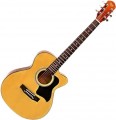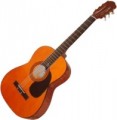Special
cutout on the body of the guitar. It is located at the base of the neck, to the right of it, if you look at the upright guitar from the front (in left-handed models — on the left). This feature makes it much easier to play on the upper frets (located near the rosette): without a cutout, the body would prevent reaching them. Therefore, this feature is highly desirable for guitarists who play notes at high frets (from the 12th and above).
There is an opinion that the cutout negatively affects the acoustics of the guitar (reduces the useful volume of the body, reduces the volume and saturation). However, in most cases, this effect is almost imperceptible, especially since manufacturers often use various tricks to compensate for this effect.
The material from which the bridge (string holder) of the guitar is made is a device with which the strings are attached to the top deck.
Theoretically, the colour of the sound of an instrument depends on the characteristics of all its details. However, in the case of the bridge, this influence is so insignificant that the data on the material in this case are more of general reference and advertising than of real practical value. The variety of such materials is quite large; among the most common are
rosewood,
mongoy and
ebony.
The number of frets provided on the neck of the guitar.
The fret is the gap between the two nut on the fretboard. By pressing a finger on the string in this gap, the guitarist changes the pitch of the string: the farther the fret (from the headstock) — the shorter the string is and the higher the sound.
The
more frets, the more notes the guitarist can take on each string and the more possibilities the instrument gives. On the other hand, for numerous frets, a fretboard of the appropriate length is needed, which affects the dimensions and cost of the instrument, and sometimes it is simply not justified: for example, ordinary guitars have at least
18 or
20 frets, while among ukuleles (see "Type ”), there are models for
12 – 16 frets.
In general, it makes sense to specifically look for an instrument with numerous frets if you plan to play complex solo parts on it; for playing chords, as well as relatively simple performance by notes, the number of frets does not play a special role.

